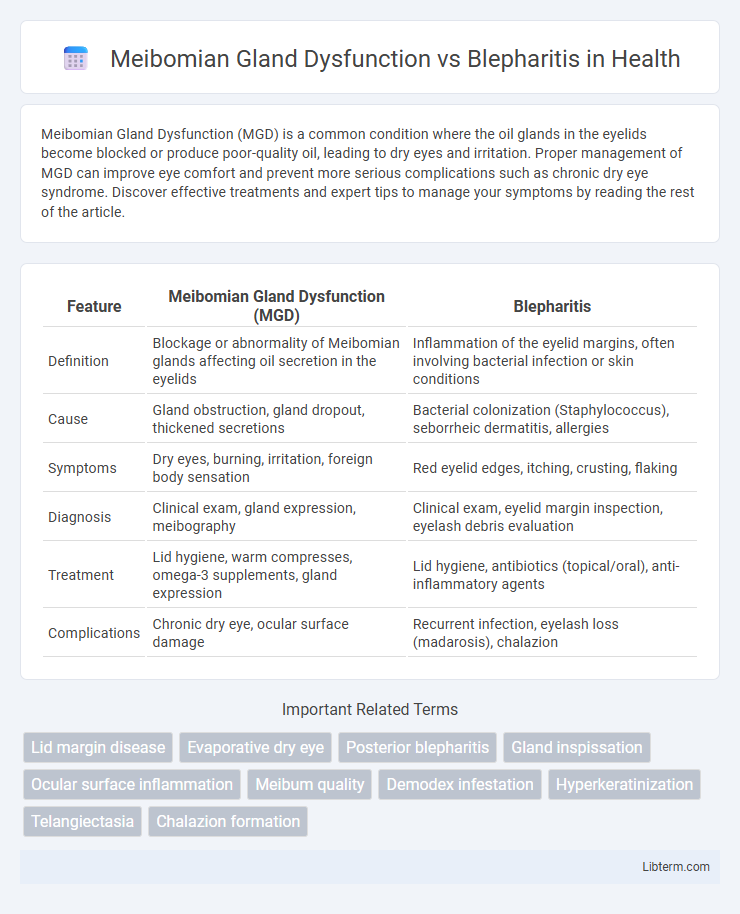Meibomian Gland Dysfunction (MGD) is a common condition where the oil glands in the eyelids become blocked or produce poor-quality oil, leading to dry eyes and irritation. Proper management of MGD can improve eye comfort and prevent more serious complications such as chronic dry eye syndrome. Discover effective treatments and expert tips to manage your symptoms by reading the rest of the article.
Table of Comparison
| Feature | Meibomian Gland Dysfunction (MGD) | Blepharitis |
|---|---|---|
| Definition | Blockage or abnormality of Meibomian glands affecting oil secretion in the eyelids | Inflammation of the eyelid margins, often involving bacterial infection or skin conditions |
| Cause | Gland obstruction, gland dropout, thickened secretions | Bacterial colonization (Staphylococcus), seborrheic dermatitis, allergies |
| Symptoms | Dry eyes, burning, irritation, foreign body sensation | Red eyelid edges, itching, crusting, flaking |
| Diagnosis | Clinical exam, gland expression, meibography | Clinical exam, eyelid margin inspection, eyelash debris evaluation |
| Treatment | Lid hygiene, warm compresses, omega-3 supplements, gland expression | Lid hygiene, antibiotics (topical/oral), anti-inflammatory agents |
| Complications | Chronic dry eye, ocular surface damage | Recurrent infection, eyelash loss (madarosis), chalazion |
Introduction to Meibomian Gland Dysfunction and Blepharitis
Meibomian Gland Dysfunction (MGD) is a chronic condition characterized by the obstruction or abnormality of the meibomian glands, leading to altered lipid secretion and evaporative dry eye. Blepharitis involves inflammation of the eyelid margins, often caused by bacterial colonization or skin conditions like seborrheic dermatitis, resulting in irritation, redness, and crusting. Understanding the distinct pathophysiology and clinical features of MGD and blepharitis is essential for targeted diagnosis and effective treatment strategies.
Understanding the Meibomian Glands
Meibomian Gland Dysfunction (MGD) involves the blockage or abnormal secretion of the Meibomian glands, which produce the oily layer of the tear film crucial for eye lubrication. In contrast, blepharitis primarily affects the eyelid margins due to bacterial infection or inflammation but can coexist with MGD, exacerbating symptoms like dryness and irritation. Understanding the structure and function of Meibomian glands highlights their role in maintaining tear stability and preventing evaporative dry eye.
What is Blepharitis?
Blepharitis is a common inflammatory condition affecting the eyelid margins, characterized by redness, swelling, and crusting around the eyelashes. It often results from bacterial colonization, seborrheic dermatitis, or malfunctioning Meibomian glands, leading to irritation and discomfort. Unlike isolated Meibomian Gland Dysfunction, blepharitis can involve both anterior and posterior eyelid inflammation.
Key Differences Between MGD and Blepharitis
Meibomian Gland Dysfunction (MGD) primarily affects the meibomian glands responsible for secreting the oily layer of the tear film, leading to evaporative dry eye and gland obstruction. Blepharitis involves inflammation of the eyelid margins and is often caused by bacterial overgrowth or seborrheic dermatitis, resulting in redness, crusting, and irritation. Unlike blepharitis, MGD is characterized by altered lipid secretion and gland dropout, making gland function assessment critical in diagnosis and treatment differentiation.
Common Causes of Both Conditions
Meibomian gland dysfunction (MGD) and blepharitis share common causes such as bacterial colonization, particularly by Staphylococcus species, leading to inflammation and obstruction of the eyelid glands. Both conditions are frequently associated with poor eyelid hygiene, contributing to lipid layer deficiencies and chronic irritation. Environmental factors like contact lens wear, cosmetic use, and systemic diseases such as rosacea also frequently exacerbate glandular dysfunction and eyelid margin inflammation.
Signs and Symptoms to Look For
Meibomian Gland Dysfunction (MGD) commonly presents with dry, gritty eyes, burning sensations, and blurred vision due to blocked oil glands in the eyelids, while Blepharitis is characterized by red, swollen eyelid margins, crusting, and flaky skin around the lashes. Both conditions may cause itching and irritation, but MGD typically leads to oily or frothy tear film abnormalities, whereas Blepharitis often involves bacterial colonization and dandruff-like scales. Recognizing these distinct signs and symptoms is essential for accurate diagnosis and effective treatment of these chronic eyelid conditions.
Diagnostic Techniques for Accurate Differentiation
Meibomian Gland Dysfunction (MGD) and Blepharitis both affect the eyelids but require distinct diagnostic techniques for accurate differentiation. Evaluating meibomian gland function through meibography and assessing lipid layer thickness using interferometry can specifically identify MGD, while slit-lamp biomicroscopy revealing eyelid margin inflammation, collarettes, and lash abnormalities supports a Blepharitis diagnosis. Tear film osmolarity testing and clinical evaluation of symptoms further enhance diagnostic accuracy, ensuring targeted treatment approaches.
Treatment Options for Meibomian Gland Dysfunction
Meibomian gland dysfunction (MGD) treatment focuses on restoring normal gland function through warm compresses, eyelid hygiene, and omega-3 fatty acid supplementation to reduce inflammation and improve lipid secretion. Advanced therapies include in-office procedures such as thermal pulsation (LipiFlow) and intense pulsed light (IPL) therapy, which help to clear blocked glands and enhance meibum quality. Unlike blepharitis, which primarily requires antimicrobial or anti-inflammatory medications, MGD treatment emphasizes gland expression and maintaining lipid layer stability to prevent evaporative dry eye.
Managing and Treating Blepharitis
Managing blepharitis involves maintaining proper eyelid hygiene through regular warm compresses and gentle lid scrubs to reduce bacterial buildup and inflammation. Topical antibiotics such as erythromycin or azithromycin ointments, along with artificial tears, help control infection and alleviate dryness. In severe cases, oral antibiotics like doxycycline or corticosteroids may be prescribed to reduce inflammation and improve symptoms effectively.
Preventative Tips and Long-Term Eye Health
Maintaining eyelid hygiene through regular warm compresses and gentle cleansing significantly reduces Meibomian Gland Dysfunction and Blepharitis flare-ups by preventing gland blockage and bacterial buildup. Incorporating omega-3 fatty acids and staying hydrated supports gland function and minimizes inflammation, promoting overall long-term eye comfort. Routine eye exams ensure early detection and management, preserving ocular surface integrity and preventing chronic complications.
Meibomian Gland Dysfunction Infographic

 libterm.com
libterm.com